HELPING PETS FIND THEIR FUR-EVER HOMES SINCE 1982
Every animal has the right to live without abuse and die without inflicted pain
Every animal has the right to live without abuse and die without inflicted pain

Halloween brings lots of fun and festivities – but sometimes, our spooky celebrations can be tricky for our pets. The ASPCA recommends these easy ways to keep your pet happy and healthy during trick-or-treat season!
Stash the Treats: The candy bowl sure is tempting – but it’s for humans only! Several popular Halloween treats are toxic to pets. Chocolate in all forms—especially dark or baking chocolate—can be very dangerous for cats and dogs. Sugar-free gum, mints, and candy containing the sugar substitute xylitol can cause serious health problems in pets.
(Xylitol is so extremely dangerous and toxic to pets that we feel it deserves special mention. It might also go by other names, including wood sugar, birch sugar, and birch bark extract. It is frequently not listed on the ingredient label, making it difficult for pet owners to keep track of what items are dangerous to their pets. Most often found in sugar-free gum and breath mints, xylitol may also be present in peanut butter, vitamins, cough drops, medications, sugar-free desserts such as chocolate, JELLO, yogurt, and pudding, and even in some products such as baby wipes, mouthwash, toothpaste, and lip balm. For a partial list of dangerous products, visit https://www.preventivevet.com/xylitol-products-toxic-for-dogs.)
Talk to children beforehand about “not sharing” Halloween loot with pets – explain that this is because we love them, and don’t want to make them very sick. Have pet-friendly treats on hand as a safe substitute for candy. If you suspect your pet has ingested something toxic, call your veterinarian or the ASPCA Poison Control Center at (888) 426-4435 immediately.
Watch the Decorations and Keep Wires Out of Reach: While a carved jack-o-lantern is festive, pets can easily knock over a lit pumpkin and start a fire. Curious kittens are especially at risk of getting burned or singed by candle flame. Popular Halloween plants such as pumpkins and decorative corn are considered relatively nontoxic, but can produce stomach discomfort in pets who nibble on them. Other potentially dangerous decorations include rubber eyeballs (choking risk), glow sticks and fake blood (possible poisons), fake cobwebs (can choke or entangle pets and wildlife), potpourri (toxic to birds) and strung lights. Watch out for those candy wrappers and plastic packaging too!
Be Careful with Costumes: For some pets, wearing a costume may cause undue stress. The ASPCA recommends that you don’t put your dog or cat in a costume unless you know he or she loves it. Be sure to have your pet try on the costume before the big night. If he or she seems distressed or shows abnormal behavior, let your pet wear his or her “birthday suit” or don a simple festive bandana instead. Signs of discomfort include folded down ears, eyes rolling back or looking sideways, a tucked tail or hunching over.
If you do dress up your pet for Halloween, make sure the costume does not limit his or her movement, sight, or ability to breathe, bark, or meow. Check the costume carefully for small, dangling or easily chewed-off pieces that could present a choking hazard. Ill-fitting outfits can get twisted on external objects or your pet, leading to injury. Never leave a costumed pet alone, and make sure you remove the costume and put it out of reach when the fun is over.
Keep Pets Calm and Easily Identifiable: Halloween brings a flurry of activity with visitors arriving at the door, and too many strangers (many in terrifying costumes!) can often be scary and stressful for pets. All but the most social dogs and cats should be kept in a separate room away from the front door during peak trick-or-treating hours and during Halloween parties. Make sure the “safe” room is familiar and comfortable for your pets, and hang a sign on the door warning guests not to open it. You can also try sitting outside your door to hand out treats.
If your pets are not already confined in their safe room, be especially careful when opening the door for trick-or-treaters or guests. Dogs and cats can dart outside in moments, especially if they are frightened. Always make sure your pet is wearing proper identification. If for any reason he or she does escape, a collar with ID tags and/or a microchip can be a lifesaver for a lost pet.
When going trick-or-treating, it’s best to leave pets safely at home. Remember that to pets, masks and costumes can change how even their favorite people look, and may cause the pet to panic or react in unexpected ways.
We hope these tips will help you make sure that Halloween is a treat for your beloved pets – this year, and for many years to come!
10/28/2022
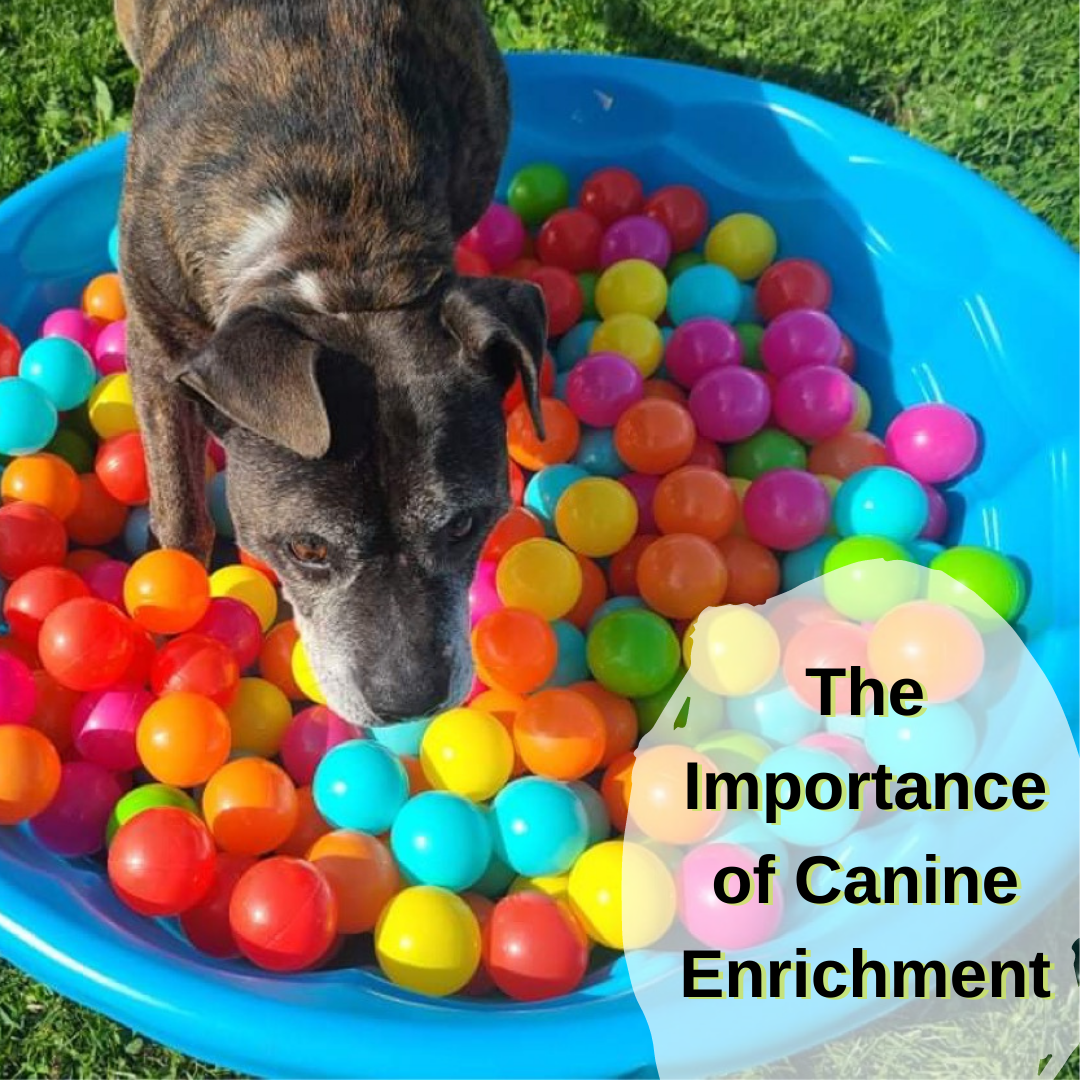
We all want to have happy and healthy dogs, and enrichment plays a vital role in achieving this goal. “Enrichment” is a big word for improving or enhancing an animal’s quality of life. Zoos across the country, and the world, are using enrichment for the animals in their care, and we can use enrichment for our dogs too! There are five main types of enrichment. They include nutritional, occupational, sensory, physical, and social.
Nutritional enrichment is arguably the easiest to employ into your day-to-day routine. Nutritional enrichment is when we make feeding time fun with treat balls and puzzles. There are tons of products available, and some of our favorite brands are Kong, West Paw, Starmark, Planet Dog, and Outward Hound. Another way to incorporate nutritional enrichment into your dog’s life is by making sure that they have plenty of options to lick and chew. Lick mats are silicone mats that have grooves to hold goodies like peanut butter, plain yogurt, or canned pumpkin. These are great for bath time, nail trims, or during storms or fireworks. Chews are widely available wherever dog supplies are sold, but be sure to check with your vet to make sure you are feeding the correct size and are not feeding anything that may be harmful.
Occupational enrichment can be so much fun for both dog and owner, and it really helps to grow the canine human bond. Like the title suggests, occupational enrichment includes giving your dog a job to do. Some examples of occupational enrichment would be playing fetch, using the flirt pole, using the treadmill, or practicing obedience cues. Dog sports are also a great option for occupational enrichment. This can include agility, trick training, weight pulling, fast cat, rally, competitive obedience, barn hunts, and more!
Sensory enrichment is all about stimulating your dog’s senses. For their sense of sight, there are interactive toys available that flash lights and/or move around on their own, therefore enticing your dog to get up and play. For their sense of sound, it may be a good idea to play a sound machine or leave a TV on when your dog is home alone. For their sense of smell and touch, the use of calming pheromones such as those provided by the company Adaptil can be used as well as the Thunderworks Thundershirt, which provides compression for a calming effect.
Physical enrichment includes changing up your dog’s physical environment. The easiest way that pet parents can do this is by rotating toys. If an old toy sits in the closet long enough it becomes new again! Also, a backyard can easily be transformed with a doggie safe pool or sand box. Walks with a long leash in a wooded area away from other dogs and people are also great for dogs to smell and decompress. Giving your dog new environments to explore without the pressure of social interactions is a great way to implement physical enrichment.
Social enrichment includes taking your dog on social walks, or to dog friendly events. It can involve your dog meeting guests in your home or checking out the livestock on your afternoon walk. For a happily social dog it is also important to encourage them to ignore people and other animals as well to balance the scale and not create an overly excited or reactive dog. We always want to keep social enrichment positive and make sure that your dog is fully enjoying the interaction. Otherwise, this can cause stress.
Canine enrichment encompasses such a large number of fun activities that it can be easy to be overwhelmed, but the best thing to do is to follow your dogs lead. If you feel you are constantly trying to change a part of your dog’s behavior, it is best to see if there is an enrichment alternative. Instead of fighting our dog’s natural behaviors, it is best to give them safe and fun outlets. Happy enrichment!
05/25/2022
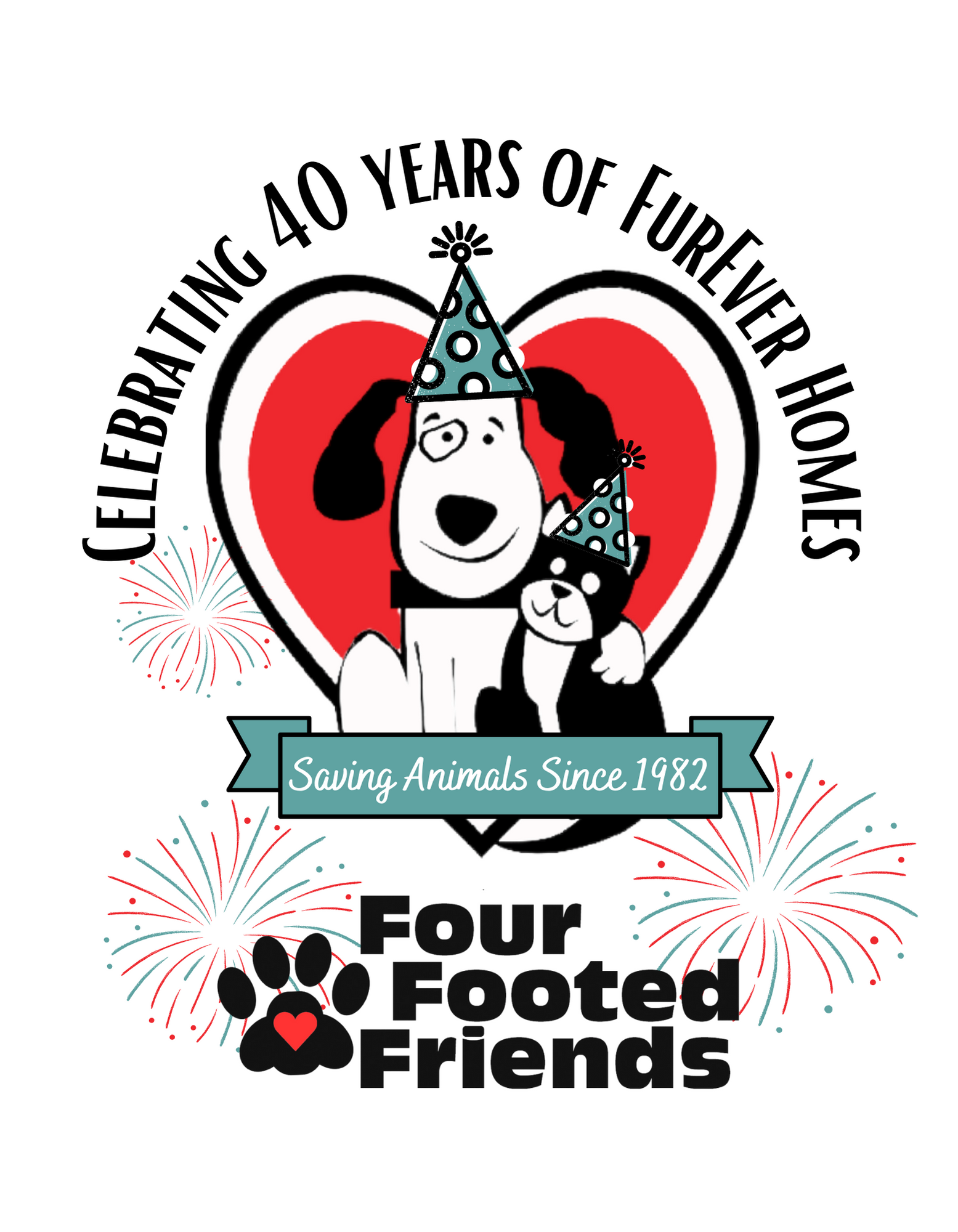
Over forty years ago, Margaret Gurison moved to Indiana, PA. She was the founder of Animal Friends in Pittsburgh. When she relocated to Indiana, she began working with a group of individuals who were helping homeless, injured, and abandoned animals. This was a passion they shared. After a time, the group of rescuers decided to incorporate. Margaret found a friend in the group who had the knowledge necessary to accomplish the task of becoming incorporated. With the proper paperwork completed, Four Footed Friends was incorporated in March of 1982. This was the start of being 40 Years Strong!
Volunteers were housing the rescued animals in their homes for a few years. Later, cats and dogs were housed in one location in a barn on the Beck Farm. Many problems began in the barn with the heat in the summer and the cold in the winter. This required an expensive cooler and turbine on top. The winter proved very cold, and a good heat source was needed. The small barn was becoming a great expense. By 1988, plans were made to set up two separate kennels: one for cats and one for dogs. This would eliminate the need for foster homes and make it easier to see all the dogs and all the cats in their own location.
Shortly after the decision was made, two separate kennels (trailers) were set-up to accommodate the increased population of animals. Dogs were housed on land belonging to our dog manager in Blairsville. The cats were housed on land in Indiana belonging to PJ Beck’s family. This arrangement worked for many years until a bigger “dream” was possible. The dream was to have the cats and dogs housed in the same facility to make it easier for their care and for families to adopt in one location.
In 2006, twenty-four years later, our new site was chosen, and the facility was built for both dogs and cats in Indiana. It took many years of fundraising to accomplish this project. Building what is Four Footed Friends’ present home, 220 Beck Road, allowed us to make significant changes to our operations. It allowed us to have a larger site to house dogs and cats, and it was also built with materials that would be easier to maintain and keep clean.
We are very proud of our permanent home and humbled by the generosity of our supporters. Being able to help the homeless, injured, abused, and abandoned animals has always been our goal and passion. We are so grateful to all who have supported us and who continue to further our mission to help. Your generous hearts and our hard-working volunteers and staff have brought us through this 40 year journey. We look forward to what the next 40 years will bring for our shelter!
03/21/2022
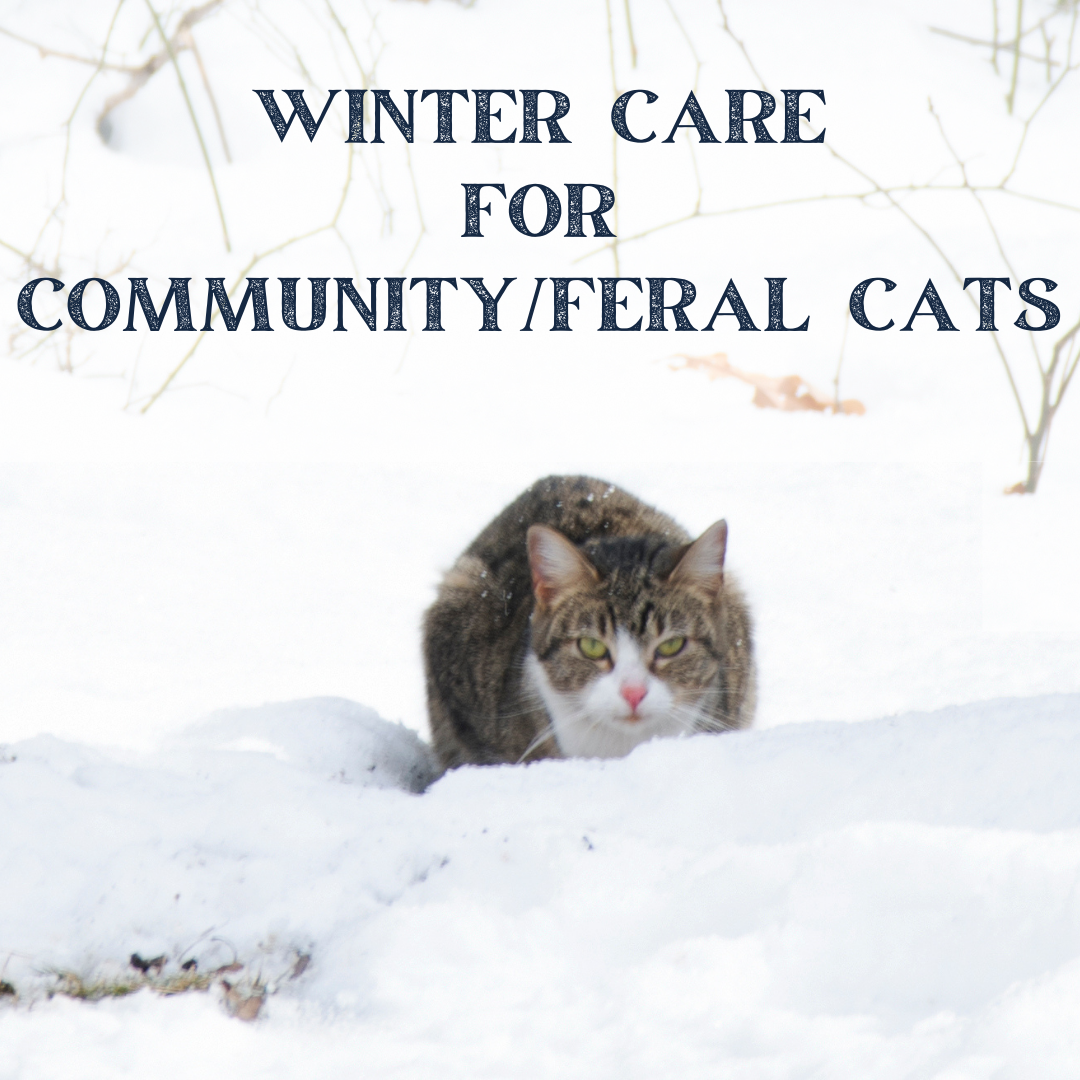
The winter months are upon us, and it is more important than ever for the feral/community cats in our neighborhood to receive some TLC. If you are a caregiver for community cats, thank you! Keep up the good work.
For those of you who want to help but don’t know how, let us give you a few helpful suggestions/information for caring for feral/community cats in the winter:
1. If a cat shows up in your yard or on your porch, the first thing you will want to do is try to determine if it is a feral cat or someone’s lost pet. If you notice that the left ear has the tip missing, that is the universal sign of a cat that has been spayed/neutered. If the cat seems to want to approach you, it may be a lost pet. Try putting food inside a crate/carrier in the area where the cat is visiting. If the cat goes into the crate to eat, close the door to keep it contained. Call your closest shelter or vet, and ask if you can bring the cat to check for a microchip. If that cat is chipped, you may be able to find the owner of the lost kitty.
2. If the cat runs and tries to hide when it sees you, it MAY be a feral cat. It is also possible it may be a pet who is just very scared.
3. The best way to help a feral cat is to provide it with shelter, food, and water. Many people build shelters from large tote containers, but anything that will shelter the cat from the elements can be helpful. There are many YouTube videos that demonstrate step-by-step instructions for building your own cat shelters. Most DIY shelters are a plastic container with a Styrofoam cooler inside. Having straw inside the cooler and placing the shelter in an area out of the wind will help your neighborhood cats to survive the winter weather. It is important to know, however, that you should not put towels, blankets, etc. into the shelter. You should only use straw which can be purchased at feed stores in your area. The reason for that is that any fabric will get wet from the cat’s body. Then, it will start to freeze, and the cat’s body temperature will drop. When this happens, the cat can freeze to the wet fabric.
4. Be sure to check water frequently. Water will freeze very quickly when the temperature is below 32 degrees, and the cats need fresh water. The same thing applies to food. Dry food should be replaced if it gets wet. Canned food will freeze and will need to be changed.
5. If you want to go a step further toward helping the community cats, you can purchase or borrow a humane trap with the goal of fixing him/her. You should make arrangements with your vet before setting the trap, but you can begin to feed the cat in the trap without setting it. This will get the cat comfortable with going into the trap to eat. When your vet gives the okay, you can trap the cat and take it to your vet to have it spayed/neutered. Many local vets will give a “feral cat price” to good citizens who are trying to help the community cat population. There may also be organizations in your area that may be able to help with the cost of spay/neuter and vaccines. While this may seem unimportant, helping to control the community/feral cat population has a huge impact!
This can be a challenging time of year for animals who are trying to take care of themselves, and they need your help to do it! We challenge everyone to keep an open mind and do their best to lend a helping hand to these cats who cannot always take care of themselves. If you have any questions about the ways you can make a difference in your community, your local shelter is sure to have further suggestions for you or a network of people you can connect with!
01/23/2022

It is hard to believe another year has passed by so quickly. The animal rescue world is ever-changing, and many days are longer than expected, which can make it seem like it goes by in a blur. However, we want to take the time to look back on what 2021 has brought us. We are pleased to say, 2021 was a successful year of animal rescuing, learning together, finding new, dedicated volunteers, and working with those who have been with us for many years.
Our volunteers put their needs aside to help our animals, and we cannot thank them enough. We were blessed with more than 100 volunteers this year who collectively worked for more than 9,000 hours to help our cause!! Without their compassion, we would not have been able to help as many animals this year. Speaking of which, we saw more than 370 cats come into our building! Some were reunited with their owners, but more than 320 were adopted to loving homes. We also saw more than 325 dogs walk through our door, and like the cats, some were reunited with their owners. We also saw more than 300 find amazing, forever homes! Despite the many adoptions, we still have a full shelter of furry companions waiting for the right person to come along.
Four Footed Friends was excited to participate in some fundraising and community events throughout the year. Through these events and the generosity of many donors, we were able to provide outreach to the community, and our animals were able to receive all of the care they needed. In regard to fundraising, every little bit helps, and we wish we could thank each person individually. Although we do our best to do so, we admit sometimes things get lost in the shuffle. If you donated this year and didn’t receive a personal thank you, please know your contribution was put to good use and greatly appreciated by both furry friends and humans alike!
We were also able to participate in the Trap, Neuter, Release (TNR) program in Indiana County. Working with Spay and Neuter Indiana PA Pets (SNIPP) and other organizations, we contributed to the ongoing efforts to curtail the homeless cat problem and assist in spay/neuter efforts in our community.
It has been a whirlwind of a year, but we wouldn’t have it any other way. Here’s to another year of working together, learning new ways to care for our rescued animals, and most importantly, finding forever homes for our homeless dogs and cats!
12/31/2021
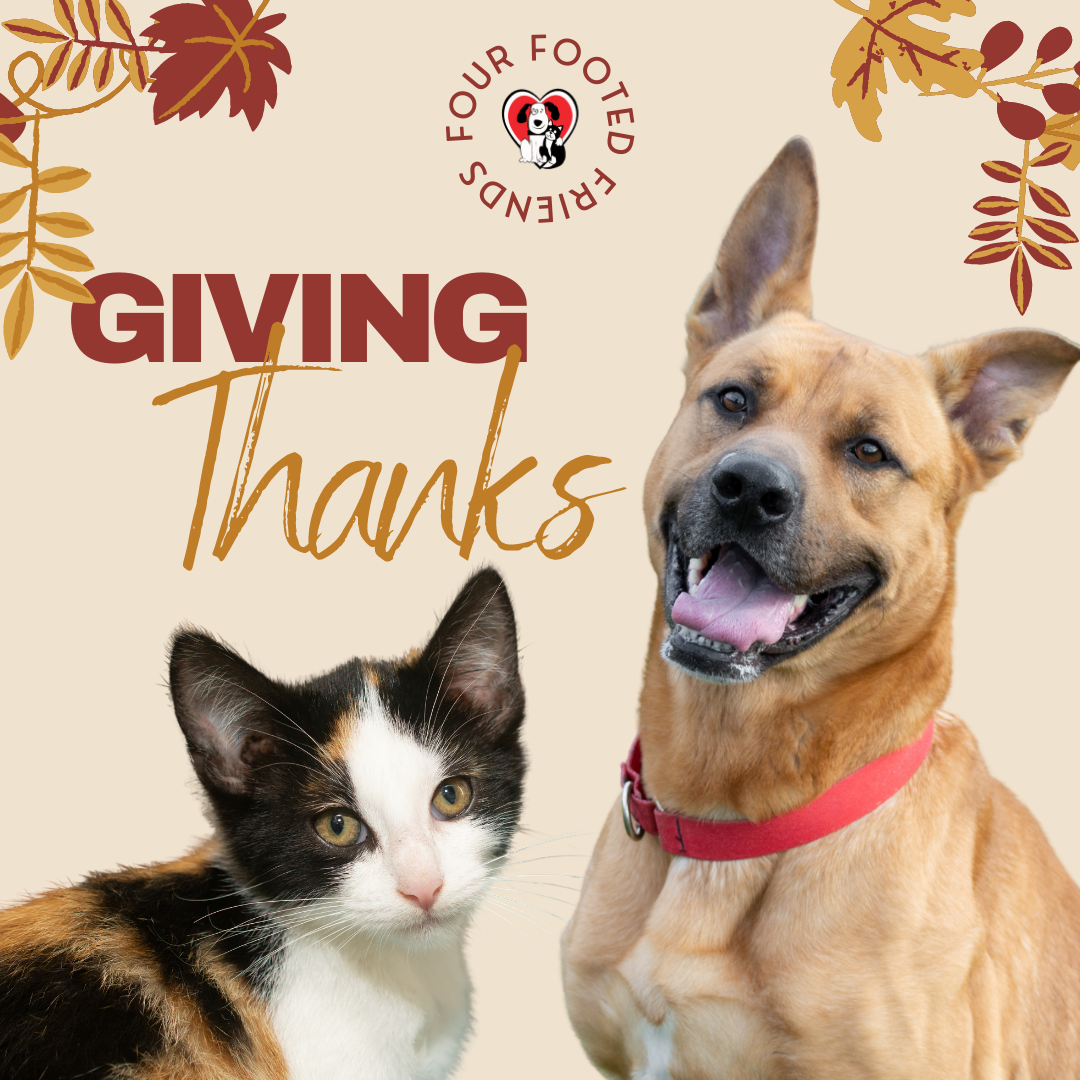
We at Four Footed Friends have SOO much to be thankful for!
First, we have a wonderful facility where we can house homeless dogs and cats who need to find homes. We can provide for their needs, keep them safe and warm, and continuously look for a forever home for each and every one of them.
We are thankful to our supporters who give us the ability to complete these tasks. Whether you donate money, supplies, your special expertise, or your time, every effort you make to help our animals is truly valuable and appreciated.
We are thankful to our veterinary offices who help us to keep our animals safe and healthy. The veterinarians and their staff do their absolute best to fit us into their busy schedule, and they are always willing to answer our questions whether by phone or email.
We are thankful to our board members who keep Four Footed Friends running with all that they do. We are a small business, and our board members do their part to operate this business in addition to their own jobs and daily lives.
We are so very grateful to our staff and volunteers who offer hands-on treatment and care to our animals at the shelter every day. Keeping up with the needs of an average of 100 cats/kittens and 20 dogs/puppies is a daunting task. The work is never done, and our folks do a great job offering their attention to our animals and keeping the shelter clean and comfy. The other folks who help with our animals everyday are our fosters. We thank them for their efforts to help raise our cats and kittens and socialize them so they can be loving companions in their forever homes.
We can’t forget our local businesses who do so much to keep Four Footed Friends running smoothly. From trainers to landscapers, retail store owners, contractors, groomers, photographers, and so many others who support us, we are truly thankful. It would be impossible to do what we do without the help of so many generous and caring people.
Lastly, we are thankful for every dog, cat, kitten, and puppy who comes through our doors and finds safety and comfort here. We are helping them, but they are helping us, too. They help us daily to appreciate the love and joy that animals bring to people. We love our Four Footed Friends residents, and we love nothing more than seeing them transform from frightened, sometimes ill animals to ones who are happily moving on to a forever home. Finally, we are thankful to our adopters who are willing to reach out to a pet in need of a home and offer their love and time to help a homeless animal become part of a family.
Thank you to everyone who helps Four Footed Friends to fulfill our mission!
11/23/2021

We have seen an influx of puppies at our shelter recently, so we thought it would be helpful to share some tips to help our adopters prepare for one of these bundles of joy!
Puppy-Proof a Play Area: Puppies are a lot like children…they will get into anything within reach. For this reason, it is important to have a secure, puppy-proof area for your new furry friend to play. Be sure to remove anything the puppy might try to eat/chew on, like electrical wires, socks, shoes, etc.
Establish a Daily Routine and House Rules from Day 1: Even though it might not seem important, routines allow puppies to feel secure. Puppies will thrive when they have meals, playtime, and training at consistent times. Also, it might be helpful to plan to bring your puppy home at the beginning of a weekend so you can practice leaving for short periods of time rather than leaving for a whole day of work immediately after getting him/her. It is also important to remember that, once you allow a behavior, it is more difficult to change it. For example, if you want an adult dog that does not jump on people or climb the furniture, be sure you start correcting these behaviors immediately with your puppy.
Prepare Yourself for Dealing with Crying, Whining, and Barking: Just like babies, puppies can make a lot of noise. However, it is important that you guide your puppy through this stage of life so he/she doesn’t start any bad habits. When dealing with crying while you are crate training, there are many guidelines and suggestions from trainers, but there is one important note most trainers will agree with. The worst thing you can do is let your puppy cry and bark for a long time and then go get him/her out and offer attention. This will teach your puppy to persistently make noise in the crate because you are rewarding the behavior. Not responding to this behavior is more effective in curbing it, assuming all of the puppy’s needs have been met.
Don’t Expose the Puppy to Public Places Until Fully Vaccinated: It can be tempting to take your puppy everywhere when you get him/her, but it is best to keep your pup at home where he/she is safe from contracting disease.
Socialize Your Puppy: It is critical to work to socialize your puppy right from the start so he/she can be a confident adult dog. Giving the puppy time with your family will help him/her become comfortable with the sights, sounds, and smells of new people. It is also helpful to safely introduce them to new things. For example, new environments, other animals, and new people.
Enlist the help of a trainer: A good trainer will teach you in how to train your puppy.
Overall, getting a puppy is an exciting experience! We urge our adopters to seriously consider whether or not a puppy is the best choice for them as it is a huge responsibility to raise a happy, healthy, and confident adult dog. If you think you are ready for this experience, consider filling out your adoption application today and noting that you would be interested in adopting a puppy. It is common for puppies to go to pre-approved adopters who have been waiting for the right one to come along, so please be patient as you work through the process.
10/8/2021
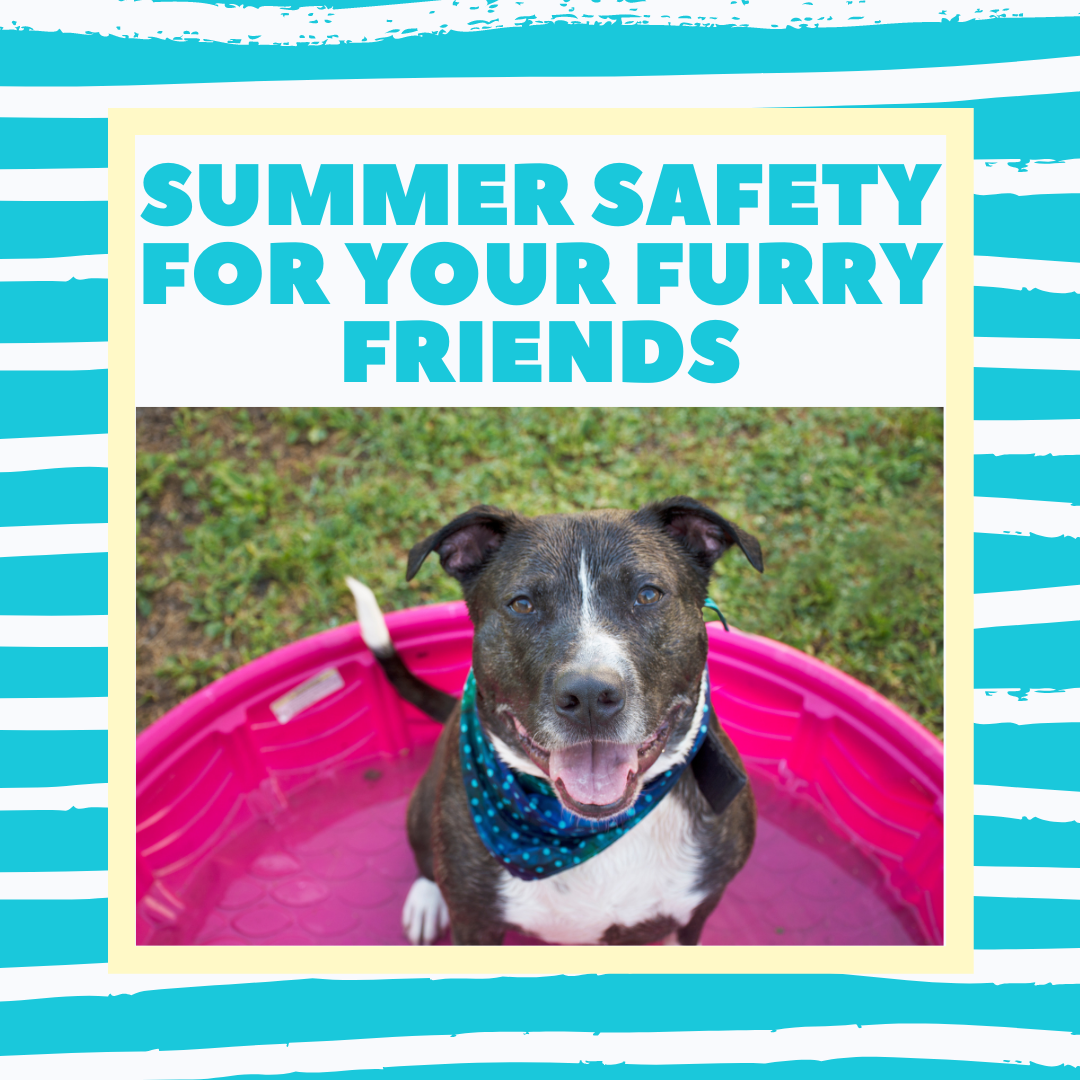
Summer has been heating up over the past few weeks, and while many folks like to have fun in the sun, it can be problematic for your furry companions. We encourage all pet parents to keep reading for more information on summer safety tips!.
Never leave your pet in a car! Parking in the shade and leaving the windows open is not enough to keep your pet cool. While it can be enjoyable to bring your pet along when you are running a quick errand, your pet’s temperature can rise rapidly, and they can overheat in a very short period of time when left in a car.
Always make sure your pet has cool, clean water available. Dogs and cats alike drink more water on hot days to keep cool. Water warms up quickly, so changing your pet’s water often is one of the easiest ways to avoid overheating.
Do not walk your dog if there are fireworks or a thunderstorm. Loud noises from the fireworks or storm can frighten them, and there is a risk that your pet will get away from you.
Do not allow your dog to hang out of the window of a moving car. Although your pup may enjoy the wind in his/her fur, this is not a safe way for your pet to travel. Objects, such as rocks being kicked up by other cars, could seriously injure your pet or he/she might fall or jump out of your moving car.
Check your pet daily for fleas and ticks. Tickborne disease is prevalent in PA, particularly in the summer months. It is important to apply flea and tick prevention to your pet as recommended by your veterinarian. There are many options available for flea and tick prevention. We recommend consulting your veterinarian to see which product would work best for your pet.
Your pet CAN get sunburn. This is more likely in white dogs, hairless dogs, and dogs with light colored fur. You can apply sunscreen to your pet before he/she spends an extended period of time outside if this is a concern. This also applies to cats. Ears and noses can be sunburned and thin-furred cats can sustain a burn too.
Don’t walk your dog on asphalt. The ground heats up quickly during the summertime, and your dog’s paws can get burned on asphalt. If you aren’t sure if the ground is too hot for your dog, do the 7 second test. If the back of your hand cannot stand the heat on the asphalt for 7 seconds, it is too hot for your dog to walk on. Try to walk your dog in the morning and evening to avoid burns.
Know the signs of heat stress. In these warm summer months it is best to be aware of the signs of heat stress by exposure to extreme temperatures. Check the animal for signs of heavy panting, glazed eyes, a rapid heartbeat, restlessness, excessive thirst, lethargy, fever, dizziness, lack of coordination, profuse salivation, vomiting, a deep red or purple tongue, and unconsciousness. If you believe your pet is overheating, be sure to call your vet immediately for treatment.
7/19/2021

When we bring dogs and cats into our shelter, part of our job is to learn as much about them as we possibly can so that we are able to place them in a forever home that is uniquely suited to meet their needs. This includes learning how they feel about other animals. Some dogs and cats come to us, and they want to be everyone’s friend. Others are more selective or prefer to keep to themselves in the shelter and in their future home. This article is intended to highlight our animals that need to be only pets. Keep on reading if you are ready to find a furrever friend that is ready to devote their whole life to loving you!
Dogs
We have many loving dogs at the shelter that need to be only pets. First up is Camo. He is a handsome 9½ year old bully mix who is seeking a home with lots of snuggles. Camo was surrendered when his owner became ill and could no longer care for him. Aside from disliking other animals, there aren’t very many things Camo doesn’t like. He is a good boy for baths and getting his nails trimmed, and he loves to go on walks and cuddle on the couch! He also has lived in a house with kids over the age of 7 successfully, and he is crate trained. Camo is an all around good pup, and if you are in the market for a dog that will be dearly devoted to you, consider filling out your application for Camo!
Chance is also looking for a special home without other animals. He was removed from his home and transferred into our care after being treated for severe skin allergies at Ebensburg Animal Hospital. He is a fun-loving guy, but he prefers to spend his time with people rather than other animals. Chance is a 2-year-old German Shepherd mix, and he is also a smart fellow. As with many of our dogs, he has an enormous amount of potential, and we have no doubt that he will be a wonderful pup for a special person that will put in the time to help him make a full recovery.
Next up, Chop is still searching for his forever home. Chop has some special needs that his new family will need to keep in mind. While Chop is a cuddle bug with many of his favorite people, he can also become protective over them. Additionally, Chop doesn’t like being left alone and can become snappy when staff return him to his kennel. Despite Chop’s difficulties, he is a smart guy that knows his basic commands, keeps a clean kennel, and walks well on a leash. He is always ready to play ball in the yard with staff and volunteers, but he prefers to play with two tennis balls so he can trade one for the other. It would likely be best for Chop and his future owners if they were willing to come in for multiple meet and greets prior to taking him home.
Like Chop, our 9 year old pittie Dozer also has special needs that his future family will need to be mindful of as he transitions into a home. Dozer has been with us for over 3 years, so he is very familiar with our routine and thrives on the structure. It will be important for Dozer’s future adopter to keep a structured environment to help him succeed. Dozer is highly food motivated which is an advantage for training, but he can be a stubborn man sometimes. He needs to have a strong leader with patience so he can learn to be his best self. Some of Dozer’s favorite things include playing in the pool, going on car rides, and going on long walks. On the flip side, Dozer does not like other animals, new people, and unfamiliar situations. He also is hoping to find someone who would be willing to come in for several meet and greets prior to leaving the shelter.
Cats
If you are more of a cat person and are looking for a feline friend that will put a smile on your face everyday, look no further! Jojo is our resident clown, and he is never shy about doing something silly to make us laugh. He has to live in a cage in our lobby instead of one of our free roaming cat rooms because he hasn’t figured out how to play nice with other animals yet. However, he is quite content to lay in his cage and roll over to show us his belly to get attention or take a nap and snore away loudly! Jojo is a good boy who will let you hold him like a baby, and he will tolerate nail trimmings. He is only about 4 years old, and he is ready to steal your heart and make you smile for many years to come!
Next, Patty is a beautiful tiger girl who is only about a year old. She came to us as a stray and we quickly learned she is terrified of other cats… She is such a loving girl, and we know she would be devoted to her person. Patty loves to cuddle and will let you carry her around like a baby. She also loves to run and play with any kind of kitty toy she can get her paws on. She’s not picky at all! Think about welcoming Patty into your home if you are ready for a sweet and fun-loving roommate!
If you like your cats sweet and sassy, think about our dilute calico Rosie. She is about 9 years old and has been with us for nearly a year. Rosie is also a special needs girl. She has IBS and is on a sensitive stomach food to control it. Rosie is the kind of girl that likes attention on her own terms. She is a good girl most of the time, but sometimes her diva side comes out!
If any of these descriptions spoke to you, consider filling out an adoption application via our website. If you are approved, staff will schedule an appointment for you to come spend some time getting to know the animal you’re interested in.
6/1/2021
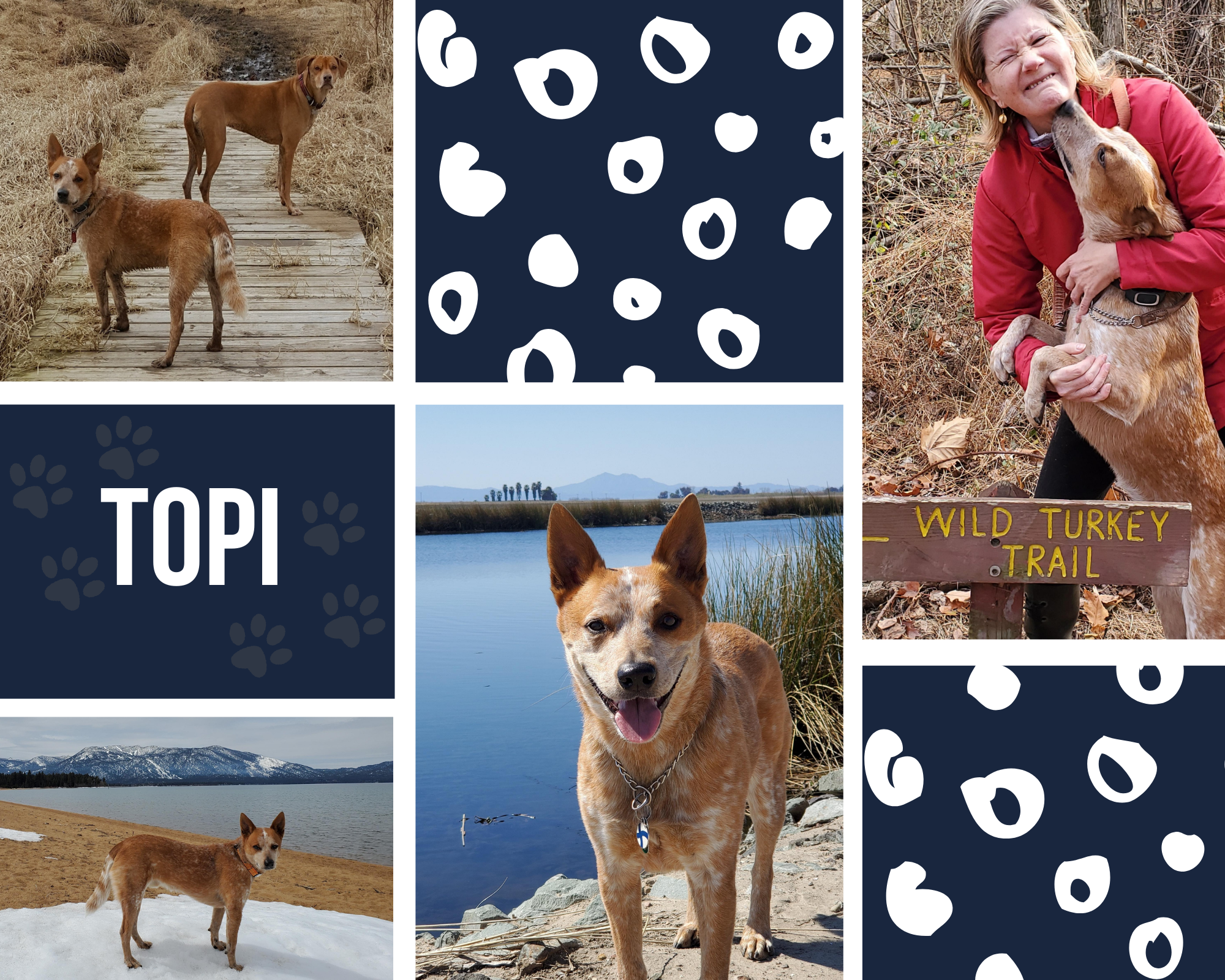
A few years ago, we got a call about a dog found at a power plant in the area where they stored their trash. The dog had severe injuries to his neck from an embedded collar as well as injuries to his paw. Four Footed Friends staff members rushed to rescue the dog and quickly realized this call was not going to be an easy one. The red heeler was terrified and fear aggressive, but our dedicated staff members who saved him took their time and were able to get him into a crate and back to FFF. We named him Reddy and got to work to restore him back to health.
Reddy needed a lot of time to decompress, and two of our staff members dedicated time every day to work with him and help him become more trusting of people before introducing any other staff members, volunteers, or visitors. It took nearly a month of working with him daily to be able to get in the same room as him safely. From there, our compassionate staff continued working with him to help him be more adoptable. Although Reddy did not have an easy start to life, his whole world changed when he met his dog mom, Suvi. When this perfect pair met, we were so excited! Suvi fell in love with Reddy, and he fell in love with her. She had the patience and ability to continue to rehabilitate him, so she adopted him and renamed him Topi.
Suvi recently told us, “Topi was on a defensive and afraid of anyone he saw, on a street or trails. The first three months, I walked with treats with me and constantly rewarded him when we saw people or other dogs. Topi has always been good with me, but he liked to nip fingers of the people who he did not know and were attempting to pet him, even looking him directly in the eyes was too much. He still cannot be trusted with strangers, but he can walk anywhere with me and not to pay much attention to others.”
Topi now travels often with Suvi, and they have had the opportunity to hike all over the country. Every dog truly does have a perfect person out there waiting, and we are so grateful to have been a part of this wonderful story! We wish Suvi and Topi many more years of adventures!
4/15/2021
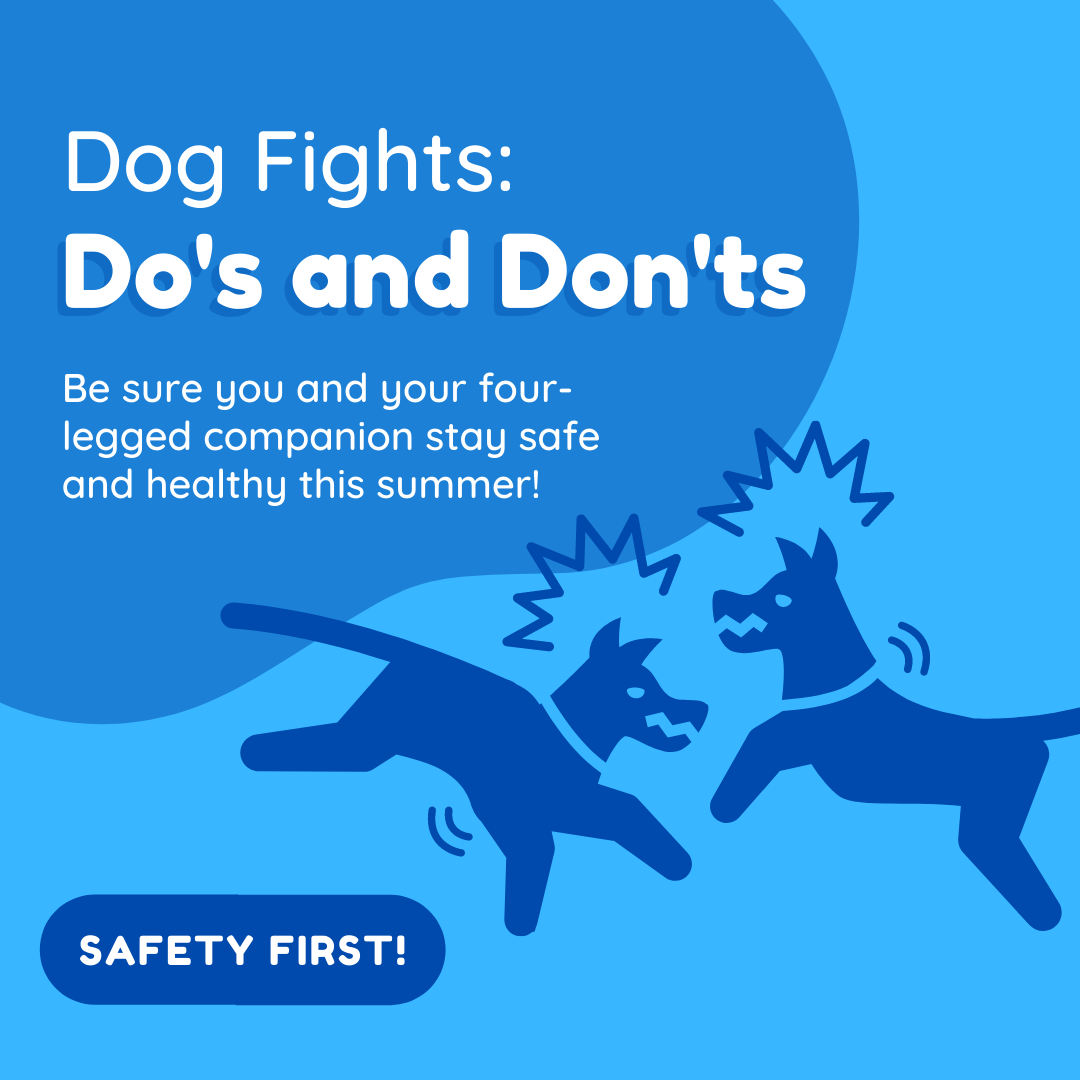
As warm spring weather settles in and summer approaches, people will be out and about more which can lead to more scuffles between neighborhood dogs. We want to provide everyone with safety tips related to keeping your dog safe during walks and what to do if a dog fight breaks out. While most of the time dogs and their owners live happy and quiet lives, we understand there are occasions where fights break out, and most owners are not sure how to break things up. We hear about dog fights that suddenly erupt at dog parks, during play dates, and on regular walks. These fights can be extremely scary for everyone involved, and it is important to be prepared in the event your dog is on either end of a fight.
First and foremost, it is crucial to remain as calm as possible when reacting to the situation. While there are many opinions about what to do to break up a dog fight, most people agree that you should never put your hands in the middle of the fight. Additionally, it is important not to grab your dog’s collar. It is best to stay as far away from the mouth area as possible because it is likely your dog will redirect onto your hand without thinking. Some common ways people break up a dog fight is to grab a nearby broom, piece of cardboard, etc. to stick in between the two dogs. ABC Certified Dog Trainer and owner of Cherryhill Canine LLC, Megan Mason, says, “If a fight does break out, my first go to's are sound and water. You can always carry an airhorn in your pocket, and if you are in a backyard, I would always have a hose on and ready. With any method you use to break up a fight, you also have to be sure to quickly pull the dogs away as soon as they release each other.”
It can often seem like dog fights happen out of nowhere, but most of the time, there is a trigger of some kind, such as food, toys, or prey drive. It is important to learn what to look for in your dog and learn their signals that indicate they are about to cause a quarrel. Megan also pointed out that, “When dealing with dogs, an ounce of prevention is worth a pound of cure. If you are taking your dog out and about, be sure to do some research on dog body language. A huge mistake that I also see regularly when dogs are greeting each other is a tight leash and tension in the air. When introducing dogs to each other, keep moving and keep the leashes loose.” If you find that your dog gets into regular fights, be sure to seek help from a dog trainer to both assess and manage the behavior. Last but not least, we hope that everyone has a fun and safe spring/summer with their canine companions. For more dog safety tips, check out the articles on Adopt-a-Pet’s website:
4/01/2021
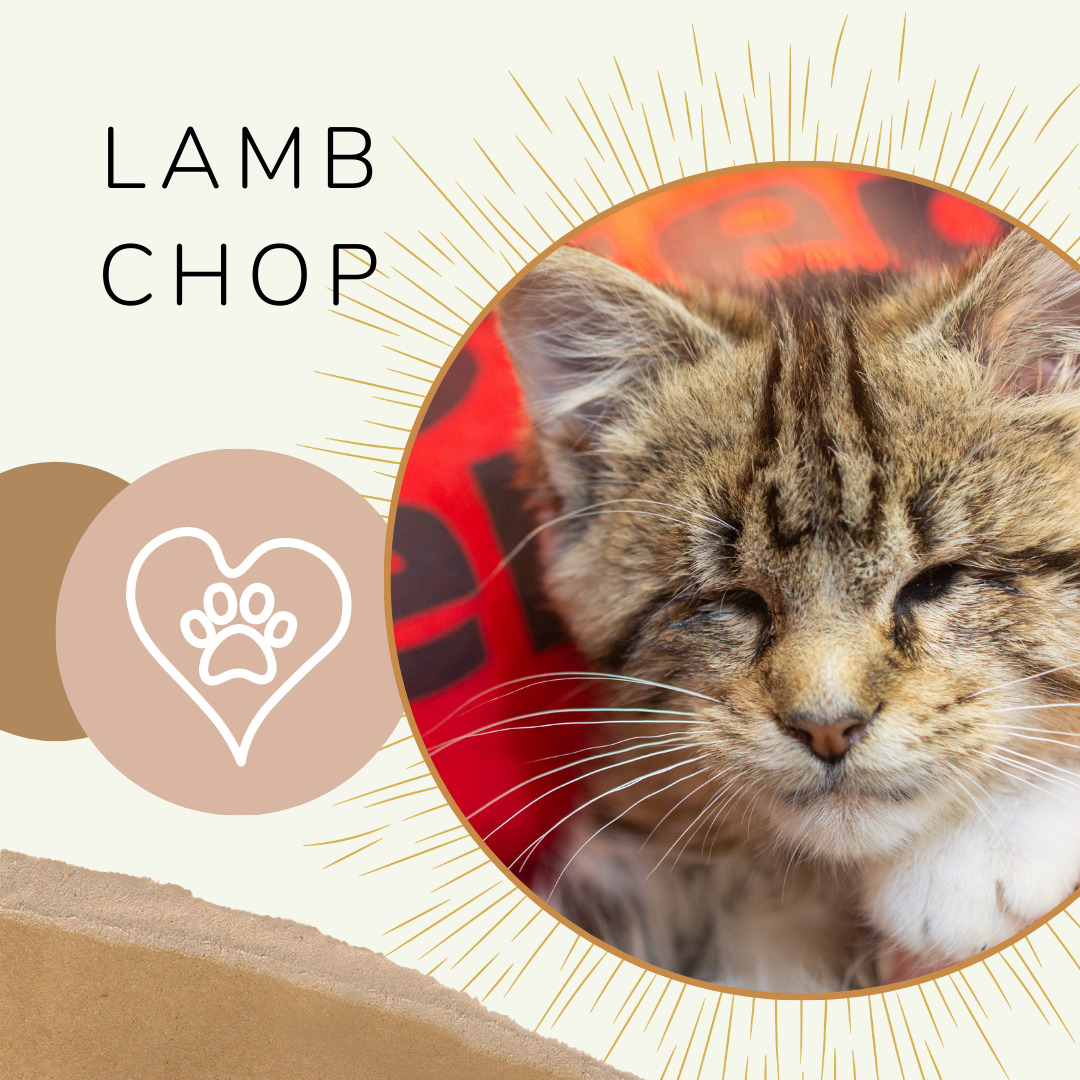
Cats and kittens can either be born blind or become blind due to illness or trauma they experience, and while it can be worrisome to think about bringing home a blind cat or taking care of your furry friend that is dealing with a new impairment, there is good news. The positive side of this situation is that animals are extremely resilient, and your cat (or the one you are considering adopting) will quickly learn to rely on other senses to navigate their new life!
Take Lamp Chop for instance. This gorgeous brown and black tiger girl came to us at the end of February. When she arrived, she was freezing, dehydrated, and blind. The staff and volunteers were concerned Lamb Chop wouldn’t survive, but we worked hard to save this sweet kitten. To everyone’s surprise, she bounced back, and now she cuddles and plays in her cage like any other kitten would. The only catch is, she will never be able to see. However, we can tell that Lamb Chop is adapting and starting to rely on her other keen senses. She truly is a friendly and resilient girl who is excited to be welcomed into the perfect forever home soon!
Whether the kitty you are bringing home was born blind or went blind due to illness or trauma later in life, they need a little extra care when transitioning into a new home. Here are some ways you can make the transition easier for your special needs friend:
#1: Keep your kitty indoors. This may seem obvious, but it is crucial to be sure your kitty stays indoors at all times! Even though your kitty has heightened senses of smell and hearing, not being able to see means he/she cannot protect himself/herself. If you want your kitty to have a chance to get a little fresh air, consider investing in a catio that will safely contain him/her.
#2: Do not rearrange your home. Blind cats do very well getting around once they figure out where things are located in their environment. Rearranging your furniture or having clutter on the floor could cause your kitty to trip over things. This can cause your kitty to be anxious and may cause them to become withdrawn because they can’t keep track of the layout of the rooms. Also, it is important to keep your kitty’s resources in the same place. Moving food, water, and litter boxes will only confuse your sightless kitty.
#3: Block stairways. Similar to the idea of not rearranging furniture, it is important to think about things in your home that could pose a danger to your kitty, such as your stairway. It would be easy for a blind kitty to step off the edge of a stair and fall down. Using baby gates to block stairs, decks, and balconies is a great way to ensure your blind kitty doesn’t tumble over the edge.
#4: Let your kitty know you’re there. It is easy to accidentally sneak up and startle a blind kitty, but consistently startling your kitty could cause him/her to be scared and anxious. It is best to start talking to your kitty so he/she knows you are approaching. This will likely put your kitty at ease so you can calmly walk up and pet him/her without causing anxiety.
These are just a few of the many ways you can help a blind kitty transition into your home. Something crucial to this process not mentioned above is patience. Please be calm and patient when working to transition a blind kitty to your home because it will likely be stressful for him/her. Be sure to show your new kitty lots of love! Blind cats can live happy and full lives, and they deserve to be loved just the same as any other kitty. It can be very rewarding to give a special needs animal a new lease on life, and we encourage you to consider if this is something you might be able to do for one of our homeless animals!
3/15/2021

Finding new homes for stray or surrendered animals is not all we do at FFF. We are often faced with accepting an injured animal and trying to decide what is best for it. Some of these injured animals are strays that someone happens to find. Most often, it is a cat or kitten who has been hit by a car or has trauma from an unknown occurrence.
Just recently, we have had several cats/kittens that suffered such accidents. Most recently, Penelope, a sweet long-haired orange kitty who came to us with a fractured jaw. She is well on her road to recovery after lots of TLC from the vet office and the staff and volunteers at FFF.
Another recent emergency case is a handsome black and white kitty who we named Flame. He was probably hit by a car, and he sustained a fractured pelvis. Luckily, he didn’t require surgery. Instead, Flame had 2 months of cage rest and has been able to recover. He is looking for a new forever home.
Gracie was a pitiful little kitten who a mail carrier found along the road during our bitterly cold winter spell. She thought Gracie had died from the cold and malnutrition, but she noticed the frail kitty was still breathing so she brought her to us. We immediately took Gracie to the vet where she was treated for her extremely low temperature, frostbite, malnutrition, and parasites. Gracie was kept by Dr. Becky at Frankie’s Friends where she could get the medical care she needed. Eventually, she will go the Black Cat Café in Pittsburgh where we are sure she will be adopted into her forever home.
Pablo is a beautiful dark calico stray who came to us with an injured paw. After her treatment and recovery, she is now at PetSmart hoping for a happy adoption very soon. There are applications being received on her now!
Sadly, not all our emergencies have a happy ending. We had a handsome orange kitty brought to us recently who sustained serious injuries when hit by a vehicle. Pike went into emergency surgery at Indian Springs Veterinary Clinic, but unfortunately his injuries were too severe and he crossed the Rainbow Bridge.
In addition to the many cat emergencies we receive, we have had several dogs who came to us with medical issues that had to be addressed immediately too. Bradford is a senior Beagle who has liver problems and bladder stones. He was in the process of being treated by our vet when he was adopted. His new owners are now going to follow up on his issues with their own vet, and we are happy to say that he will spend his remaining years in a loving home.
We have had numerous dogs with skin issues and GI issues. It takes much investigative work from both staff and veterinary offices to determine what is causing the problems and how to best help them.
The heartwarming part of this story is that we are able to help animals in these unfortunate cases because of the generosity of our supporters. The expenses we incur from our vets are substantial, even with the generous discounts our regular vets offer. We often post stories on Facebook requesting donations when we receive an animal in need of special medical care. We want to sincerely thank all those who have donated in the past. Every dollar that is donated for these unfortunate dogs and cats go toward their medical expenses. Without our faithful supporters we wouldn’t be able to do what is needed for these animals.
3/1/2021

You may have heard shelter workers claim that “kitten season is coming.” What does that really mean? Well, a female cat goes into heat when she is approximately six months old, and there are many stray and feral cats out on the streets in every neighborhood that are having kittens in the early spring and into the summer months. This is a time where shelters are often scrambling to accommodate the influx of cats and kittens.
Once a stray female cat goes into heat, it is just a matter of time until they get pregnant. The gestation period for cats is about 65 days, so every spring, these stray cats produce their litters of kittens. The average, unspayed female cat will have three litters per year. The average litter size is four kittens.
It is easy to imagine how rapidly two stray cats can turn into an overwhelming colony of cats. Statistics show that 2 unaltered cats and their offspring, if all are unaltered, can produce an amazing 420,000 cats in just seven years! Of course, many of those kittens do not survive, but if even half of those strays survived, there can still be over 200,000 new cats in the world in need of homes!
There is a simple solution to avoid this over-population of cats. That simple solution is to spay and neuter cats, whether they are your pets or stray cats in the neighborhood. When addressing strays, there are vets and organizations that offer low-cost spay/neuter surgery to alleviate this problem. Stray cats can be trapped and sterilized, then returned to their neighborhood. As long as they have shelter and a food source, they can live happily in their neighborhood. They will not reproduce, which keeps the number in the colony stable. Since they won’t be fighting for mating rights, spraying and other unwanted behaviors will be greatly reduced.
For your pet cats, sterilizing them also prevents those unwanted behaviors. It also promotes better health for your cats. A spayed female has a significantly lower chance of getting breast cancer and a s female will not contract pyometra which is an infection of the uterus that is very common. A neutered male will have no risk of developing testicular cancer and will have a greatly reduced risk of developing prostate problems.
If you have cats in need of sterilization, contact your vet or your local shelter/rescue group. They can all guide you to the best resources in your area. Please do your part to make this year’s kitten season a little more manageable.
2/15/2021
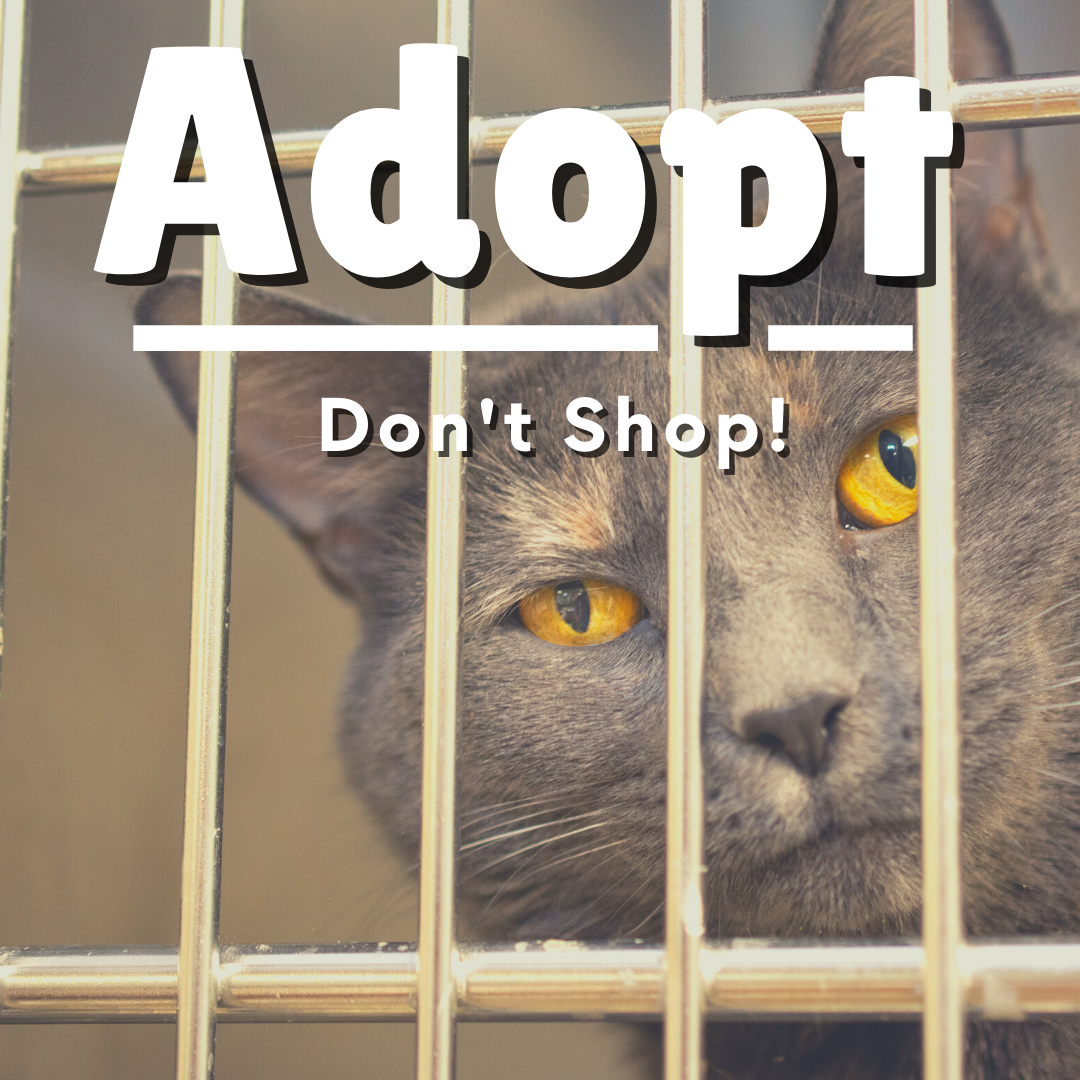
In the rescue world, you will hear shelter staff and animal lovers alike using the phrase “adopt don’t shop,” and you might ask yourself why… There are some clear benefits to animal ownership. More specifically, there are obvious benefits to adopting from your local shelter.
While this is not an exhaustive list, you can see that adopting can be both rewarding and fun for you and your new furry companion. At Four Footed Friends, we pride ourselves in advocating for our animals and promoting adoption whether it is at our shelter or another shelter. Remember, adopt, don’t shop!
2/1/2021
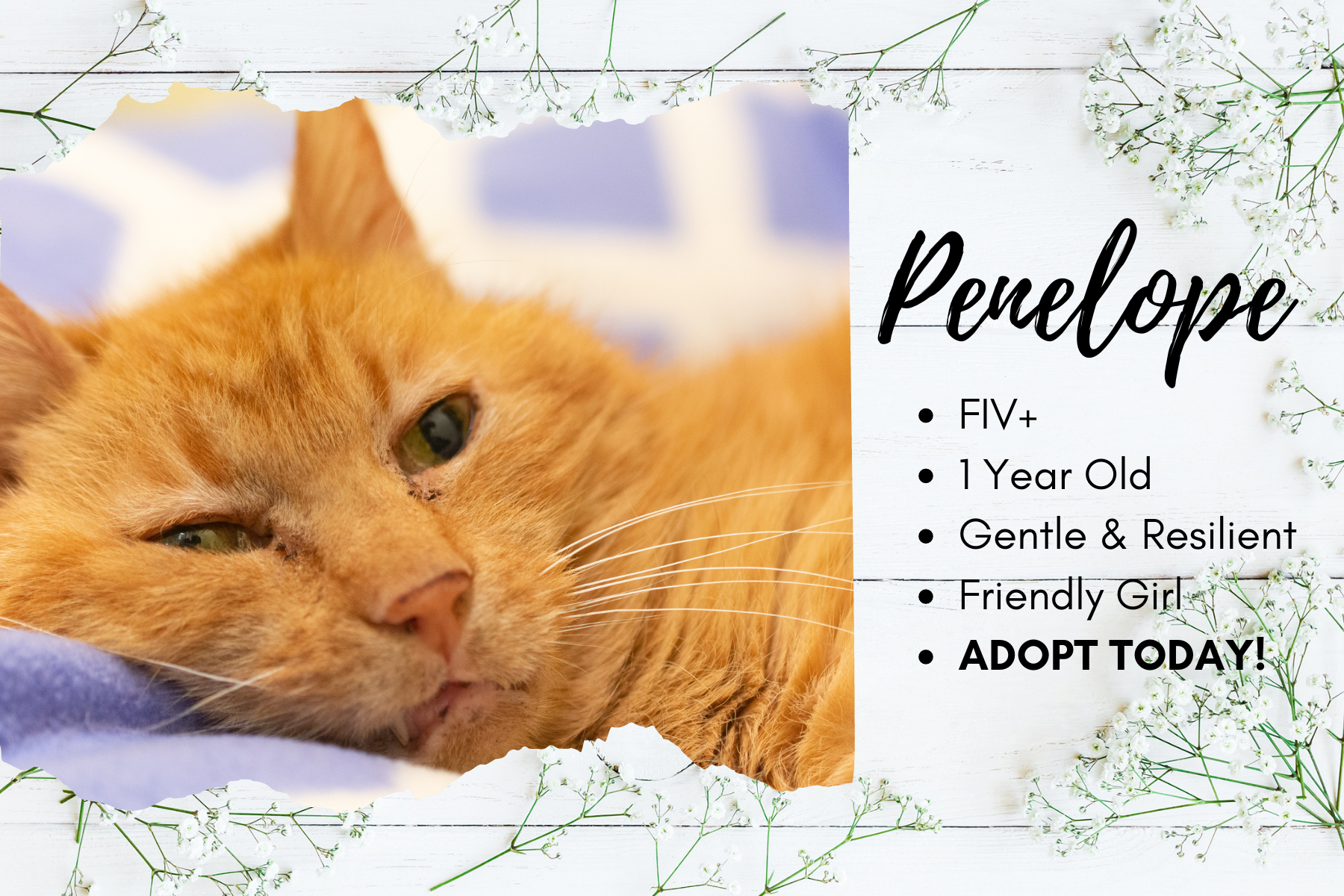
Poor little Penelope has had a rough life so far. She was found soaking wet in a cold stairwell on a dark night nearly frozen. The kind lady who found Penelope took her home to warm her and feed her. It was then she discovered Penelope had some serious medical issues. She brought Penelope to FFF so we could get her much needed medical care. Poor sweet Penelope had a fractured jaw, along with other bodily injuries. She had a flattened tail, but we will never know why. Perhaps she was hit by a car or experienced some other traumatic episode. We also found out that Penelope is FIV+.
On the bright side, Penelope is making a fantastic recovery from the trauma that she suffered. She is quite a friendly little girl, and her jaw fractures have healed which means she is now able to eat normally! She is a resilient, happy little furball. She is sharing her room with a few other cats and living in harmony with them. Though she is FIV+, she can be with other cats as long as they are not fighting. Penelope doesn’t seem to have a mean bone in her body, so she is getting along quite well with her new feline friends. She would LOVE to go to someone’s home, though, where she can get lots of love and attention. If you are interested in meeting Penelope, please submit an adoption application for her.
As you can imagine, the cost of Penelope’s emergency medical expenses was quite high, and we help cases like Penelope on a regular basis. It is only because of the generosity of our donors that we can take, treat, and adopt out cases like Penelope. Our fundraising has been negatively impacted by the pandemic which means we are relying on your generosity to help rescue dogs and cats in severe distress. If you have it in your heart to make a donation, you can find a “Donate” button under the “SUPPORT US” tab on our website. Any amount, large or small, is greatly appreciated during these difficult times. Every little bit helps! Thank you in advance for your generosity
1/15/2021

Brr it’s COLD! Winter is here, and it is important that you make adjustments to your normal routine to keep your pets happy and healthy during the winder months. Under Libre’s Law, passed in 2017, it is illegal to leave your dog tethered outside for more than 30 minutes when the temperature dips below freezing.Please remember to bring your animals inside this winter and know the signs of frostbite and hypothermia.
Frostbite commonly occurs on your pet’s paws, ears, and tail. Some signs are paleness of the affected skin, coldness, and pain in the area when touched. Hypothermia occurs when your pet’s temperature falls below normal, and he/she is unable to keep up with the loss of heat. Check your pet’s gums for paleness. Additional symptoms include shivering and a slower heart rate. Hypothermia can be fatal if left untreated, so be sure to stay vigilant of the symptoms.
Many people forget about the importance of paw care in the winter months. Just like we need to protect our feet when it’s cold outside, our dogs need additional protection in the winter too. Be sure to protect your pet’s paws from the snow, freezing ground, and salty asphalt/concrete surfaces. Rock salt and chemicals used to melt ice can cause severe dermatitis and inflammation on your pet’s paws. To prevent ice balls from forming between and around your pet’s paw pads, trim your pet’s toe/foot pad fur. Applying a balm to the pads of your pet’s feet can also add a layer of protection from the elements. Another option is to purchase pet boots to protect your pet’s paws as well as provide them warmth and more traction on slick surfaces.
It’s also important to remember to take care of your pet’s fur and be mindful of fleas and ticks during the winter season. To keep your pet properly insulated during winter months, it is essential to have a well-groomed coat. Keep in mind, short-haired and long-haired pets are vulnerable to cold temperatures. Consider purchasing a winter sweater or jacket for your pet. Also, remember the myth that “cold weather kills fleas and ticks”. Since your home is heated (above 65 degrees), it’s the perfect sanctuary for fleas to be during the winter months. Ticks are capable of surviving cold temperatures, particularly when they are able to find a host to feed from. Remember, flea and tick prevention are essential throughout the year!
Have a safe and cozy winter with your pet!
1/1/2021

The holiday season is in full swing. Needless to say, it has been a unique and challenging year. In the midst of all the challenges, one thing remains the same… we have adopted out MANY animals to loving homes! We are thankful to the individuals and families that have welcomed new furry family members into their homes this year. If you’re considering adopting before the holidays, we would like to offer some tips and suggestions.
Every year our shelter workers and volunteers meet people who, with the best of intentions, are trying to buy/adopt animals for a family member or friend as a perfect Christmas present. Sadly, shortly after the holiday season, we find that people either do not want the animal, or they cannot handle them, and they bring them back to the shelter. It is so very important to remember this holiday season that animals are responsibilities, not presents. We believe in pairing potential adopters that are ready to take on the responsibility of having a companion animal with the dog/cat that best fits their needs and lifestyle. For this reason, it is vital that the primary caregiver of the animal be the one to choose their new furry friend. If you would like to give the gift of a new companion, consider paying the adoption fee and allowing your loved one to make the connection and choice of which pet touches their heart. Animals develop a special connection with their humans, and this connection often happens at the shelter. We have seen so many adopters enter the shelter certain they are adopting a particular animal based on pictures but leave with an entirely different pet because of the connection they felt with him/her.
There are a few things to consider and be aware of when adopting a pet. It takes animals time to acclimate to their new environment and understand that your home is their home. They will likely be nervous at first, and it can take them several weeks to become comfortable. During this time, it is important not to surround them with too many new and unfamiliar people as this will not set your new companion up for success. Also, if you do have guests, please be aware of where your new dog/cat is when people are coming and going. It is easy for a new and frightened dog or cat to quickly slip out the door when guests are entering or leaving, and since the dog or cat might not be bonded to you yet, it could be impossible to get them back.
One of the most important roles of FFF is to advocate for the needs of our animals. The take-away we hope to share is that while adopting is exciting and pets bring joy to our lives, please remember pet ownership is not just for the holidays. Pet ownership is for the duration of the animal’s life. While it is our sincere wish that all of our animals would have a home of their own for the holidays, adopting a puppy or kitten is often a 15-20 year commitment. Adopting an adult dog or cat is also a substantial commitment, and it is important to understand the responsibility that comes along with making them a part of your family. Adopting an animal means welcoming him/her into your home and your heart and caring for all of their needs, physical and emotional.
12/15/2020

Three years have passed, and Dozer is still sitting in his same kennel… the 6th kennel on the left. Many people have come to see him, but nobody has taken him home. He has seen many furry friends come and go but has not had his chance at a forever home yet. You might ask why Dozer hasn’t found his forever home in the 3 years he has been at Four Footed Friends (FFF)… let’s flash back 3 years ago to explain!
On November 29, 2017 Dozer arrived at our shelter as an owner surrender. His family was moving, and he was not able to go along. You can imagine the heartbreak he felt being abandoned at a place he had never been before. Dozer was terrified, and he had his guard up. It was quite some time until Dozer became comfortable with the routine and staff handling him. Since then, Dozer has adjusted very well to the shelter environment, but he is still searching for a home!
Dozer is a special guy, so finding him the ideal home is not an easy task. When considering prospective placement, safety for our dogs and potential adopters is our biggest priority. There are several very important qualifications a potential adopter must possess before welcoming Dozer into his/her home. First, Dozer must be the only pet. He does not like other animals and never will. Someone who has a large property without neighbors that have pets would be even better! Second, he needs to be in an ADULT ONLY household. Dozer is very large and is not always a gentle giant. He often forgets how strong and bulky he is, so he is not child friendly. Third, Dozer needs to go to a home with someone who has experience with large breeds and is willing to work with him. Dozer needs structure and authority to keep him in check. The day Dozer gets adopted, his life will change dramatically. It is important to remember, he has had the same structured routine with familiar people for 3 years, so he will have a lot of adjusting to do. During this time, he will need strong owners to steer and guide him. Additionally, it will be important for Dozer and his new family to work with a trainer to help with this adjustment. The last and most important requirement for someone to adopt Dozer will be a commitment to make many visits to build a bond with him prior to adoption. Dozer is most likely not going to like you the first time you meet, maybe not even in the second meeting. He will love and trust you on his own terms like he has done with our staff and volunteers. Once you gain his trust, he will greet you everyday with his classic pittie smile and will “give hugs” because he is so happy you’re home!
We do not believe animals should be euthanized simply because they do not have a home. Therefore, animals remain in our shelter until we find the right home for them, and Dozer is no exception. We know the ideal person for Dozer is out there, and if it takes another 3 years to find them, that is what we will do! Dozer is very special to many people at FFF, and we want what is best for him. We would like to extend our thanks to the individuals who support FFF through donations of money and/or supplies. Your donations go towards helping us further our mission and helping dogs like Dozer!
12/01/2020
Everyone has heard of amazing shelter stories that showcase unlikely pairs coming together, sharing new experiences, and overcoming life’s obstacles. These are the stories our staff/volunteers live for! It is the reason we do what we do, and it is why we work so hard to be the voice for the incredible animals in our care. We see their potential and are waiting for that special someone to come along and see it too. The most recent case of hidden potential at the shelter was Henry who became an emotional support animal (ESA) for his new owner.
Henry came in as a spunky, little Jack Russel Terrier who did not enjoy many other dogs, but he bonded strongly with several people. When his new dog mom came into the shelter, she immediately fell in love with this spirited bundle of fur. It turns out, he was just what she needed. She tells us, “Henry has been such a good companion to me so far. When I first got him, I noticed some anxiety, but I think we help each other out! He has a good way of identifying when I am upset and will come over and lay with me to make sure I’m okay.” It is amazing how people come in to rescue a dog, and they leave realizing the dog rescued them too!
Aside from selectively placing our animals in their forever homes, we believe it is important to provide our community with education on animal services, care, and welfare. Today, we want to share the different classifications of dogs because there are often misconceptions about terms like emotional support animal, therapy animal, and service animal. We frequently see people mistaking the meaning of these terms and using them interchangeably, but the reality is, they all represent different levels of training and service.
Emotional support animals, like Henry, are personal companions for individuals. These dogs do not require any specified level of training. For that reason, they are not allowed to go everywhere with their owners, and they are not protected under the Americans with Disabilities Act. At the shelter, we have proudly connected many individuals with an emotional support animal to help them work through a variety of mental health diagnoses. The next level of service is therapy animal. These animals also are not allowed to go everywhere with their owners. They must be invited into places for visits. These dogs are calm, house trained, and nonaggressive. They are typically owned, trained, and handled by a volunteer who takes the dog to places like nursing homes and schools for visits. The last level of training is service animal. These dogs are highly trained and are the only category of dog that is protected by the Americans with Disabilities Act. This means they have guaranteed access to public places. These animals are typically trained by a professional for 1-3 years to help someone with a physical or psychological disability. As you can see from this information, these are all vastly different categories of training level and public access, and it is important to know the difference! If you are out in public, it is important to know that service animals are doing a job, so it is vital to respect their space and allow them to do the job they were so extensively trained to do.
We hope to be able to see many more stories of animals doing amazing things for their humans, and we hope to continue to be a part of many happy stories! As the holiday season approaches, we hope you will consider helping to support the work we do uniting families with the perfect companion animals. If you are interested in donating, jump over to the “Support Us” tab on our website to see the ways you can lend a helping hand. Thank you for your support through these challenging times! We appreciate each and every one of you!
11/15/2020
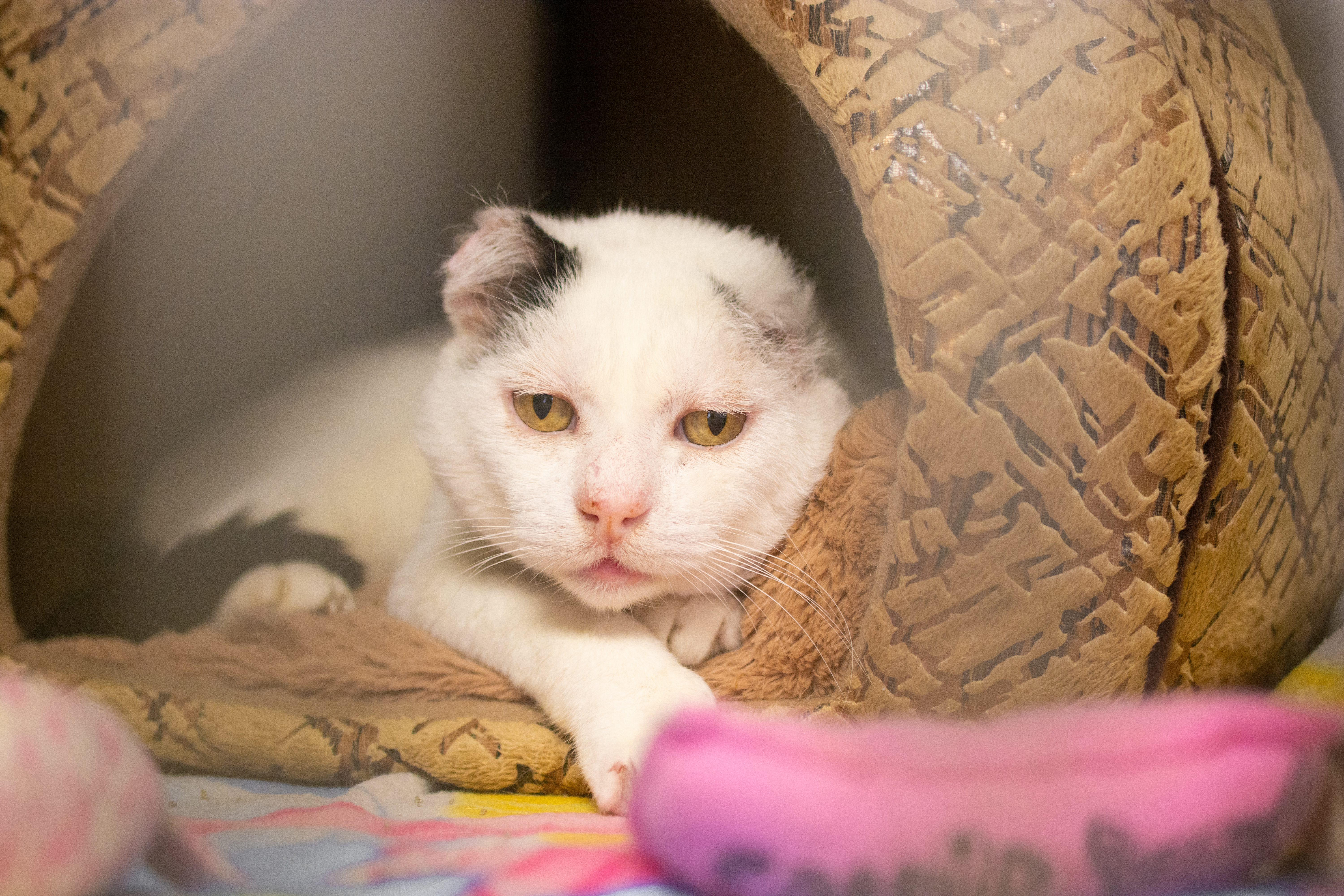
You might be thinking this black and white kitty looks a little different than most, and you would be right. Patches came to us with substantial injuries. His ears were badly infected, he was infested with fleas, and his teeth were in terrible condition. We quickly got Patches to the vet and realized his troubles went beyond what we could visibly see. One of our vets informed us that Patches was positive for Feline Leukemia (FeLV), and it turns out, he had tumors beneath the infection on his ears. Luckily, the tumors (and his bad teeth) were removed, and once he started to heal, Patches began showing off his true, cuddly purrsonality!
We know this good-natured boy will make the perfect companion for someone who appreciates regular kitty snuggles! Patches currently spends his days in a cage in our front lobby to keep him separate from our FeLV negative kitties. He is hopeful that someone will be willing to open their heart and home to him soon. Dr. Becky Morrow, Medical Director and Lead Veterinarian at Frankie’s Friends, says “The biggest thing I have seen in my 22 years is that cats that acquire Feline Leukemia as kittens almost always have a very short lifespan of about 1.5 years. I have seen a couple of FeLV positive cats live normal lifespans and never show signs of the disease. Adult cats have a much better chance of fighting off the virus if they are exposed, but vaccination 3 to 4 weeks apart for two doses is nearly 100% effective.” This is a reminder to everyone… PLEASE vaccinate kittens/cats in your care to keep them healthy! We test our cats for FeLV, and make sure all cats/kittens in our care receive all the needed preventative treatment (vaccines, flea treatment, de-worming medicine, etc.) to keep them healthy and prepare them for their forever homes.
Now that Patches has received all the needed veterinary care to get him back to his happy-go-lucky self, he is ready to find his forever home. Patches is approximately 3 years old, and he is currently asymptomatic and seems to be relatively healthy. Overall, Patches is doing very well with us. However, he is hoping a loving, understanding person will come soon! Patches should live in a house with only FeLV positive cats OR with no other kitty friends because FeLV is contagious to other cats. Patches is known at the shelter for “head butting” staff/volunteers for attention, and he would sit in our arms all day if we let him. He is the ultimate lap kitty, and he wants you to know “there are few things in life more heartwarming than to be welcomed by a cat” ~Tay Hohoff. If you are able and willing to provide Patches a loving home, he promises to welcome you home regularly and show you all the love he has to offer!
11/1/2020
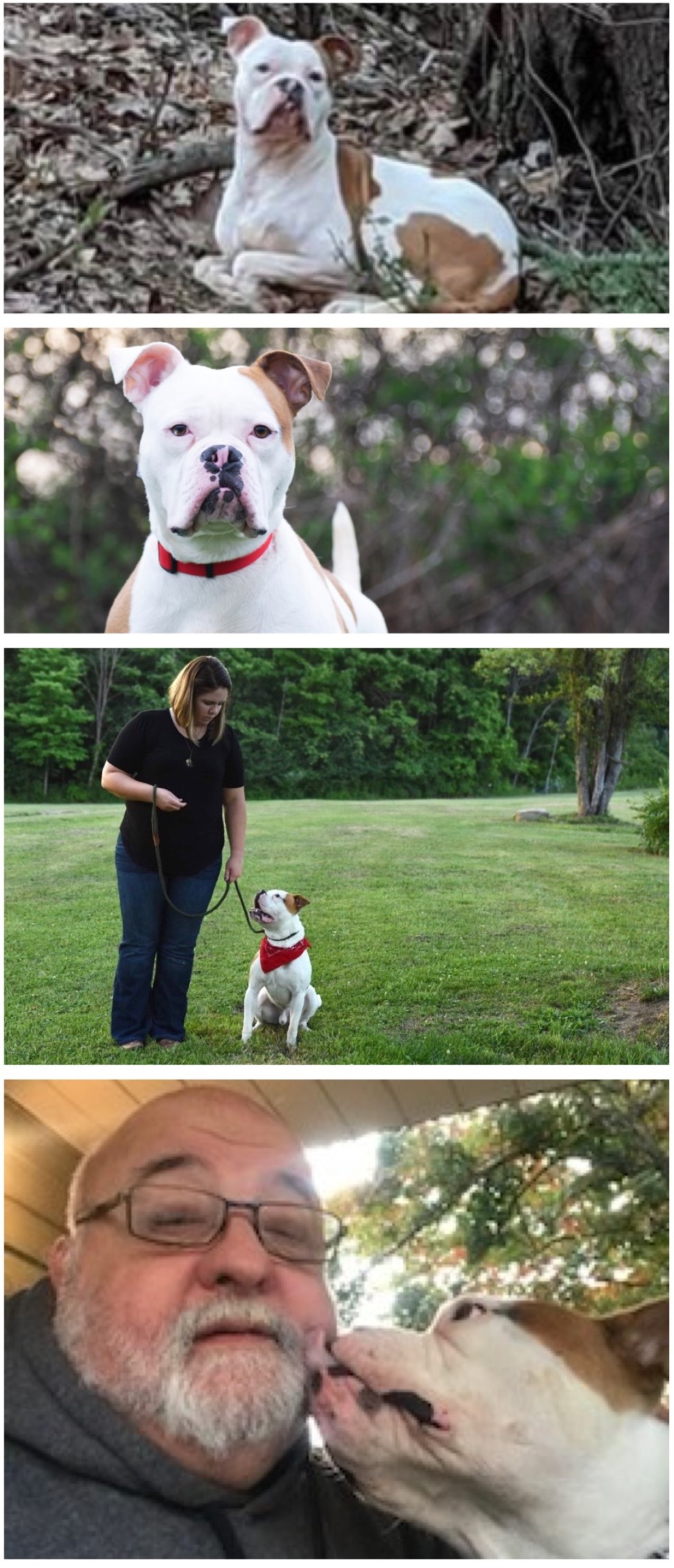
On a cold and blustery day in the height of the COVID-19 pandemic, we received a call from a man who found a brown and white bully mix abandoned in the woods. After checking to see that the dog did not belong to the property owner, the good Samaritan went to get a bag of dog food and hot dogs to try to coax the dog out of the woods. Jeanne (director) and Jen (dog manager) rushed to Plumville to try to rescue the dog who the man had named Teddy Bear.
When they arrived on the scene, Teddy’s eyes told them everything they needed to know. He was full of fear and uncertainty and showed fearful aggression toward his rescuers. After several long minutes trying to coax Teddy out of the woods and toward the shelter’s van, he came forward and accepted treats from Jeanne and Jen. They tried to get him into one of the crates in our shelter’s van, but Teddy was not having any of that… They decided they would have to let him ride in the back of the van. Within five minutes, Teddy Bear had planted himself on Jen’s lap, shivering against her. Evidently, Teddy was starved not only for food but for attention as well. As Jeanne drove them back to the shelter, Jen calmed Teddy and assured him that he was safe now and would never be hurt again. He and Jen formed an unmistakable bond during that van ride, and she and staff were highly motivated to go above and beyond to ensure Teddy would be able to transition successfully into a loving home.
Despite everyone’s enthusiasm to help Teddy, his stay at the shelter was not an easy one. He was very leery of everyone at the shelter, demonstrating what is known as “stranger danger” or human fear reactivity. It took some time before he accepted anyone other than Jeanne and Jen. Each person had to give Teddy a lot of space and let him decide to approach when he was feeling comfortable enough. This behavior placed Teddy at a disadvantage for placement. However, we also know with proper training, dogs can learn to trust and become great additions to informed, committed families. Once Teddy got to know our staff members, it was clear Teddy had a quirky, jovial personality, and we were learning new things about him every day! We quickly found out Teddy loved to play ball in the yard and was quick for hugs. As time passed, it was clear Teddy needed training that we could not provide at the shelter.
Luckily, we had met Megan Mason who was in search of a dog to work with as she completed her certification to become a dog trainer. Jen contacted Megan and shared Teddy’s story. She fell in love with Teddy, and for several weeks, she came on Saturdays to take Teddy on day trips for training. Teddy knew when it was Saturday morning. He would wait patiently (okay, maybe not patiently) for Megan to come. During the week, staff enforced the skills Megan and Teddy worked on in their training sessions.
After spending countless hours at the shelter with Teddy, Megan finally felt he was ready for a new adventure! Teddy went to Megan’s home so he could receive the constant training he needed to succeed. This was Teddy’s big break! Megan was able to provide Teddy with positive training and reinforcement that allowed him to flourish. She selflessly put in the work and witnessed Teddy making great strides. Soon, #Teddysjourney became a fan favorite of our social media followers, and this was a great way to share his progress!
We started to receive countless applications for Teddy. After several meet and greets, Teddy picked his person! We are so very happy to share the great news! Teddy has been adopted by an amazing family who understands his sweet, playful, and quirky personality. This began Teddy’s transition to his “fur-ever” family. Megan told us “Teddy was so much fun to work with and is such a happy boy! He is the prime example of a dog that acts completely different in a shelter situation versus a home. I’m so happy that I had the opportunity to understand Teddy’s issues and help him settle into his forever home.” Teddy’s new family is still getting to know him, and he is still learning what it is like to be a member of a loving family. We are thankful Teddy has found an understanding family, and we appreciate Megan who is graciously helping with his transition.
It truly was a group effort to help Teddy on his journey from being abandoned in the woods to being the loving companion he is now. We want to thank all those involved in rehabilitating this handsome bully mix with the toothy grin!
10/15/2020
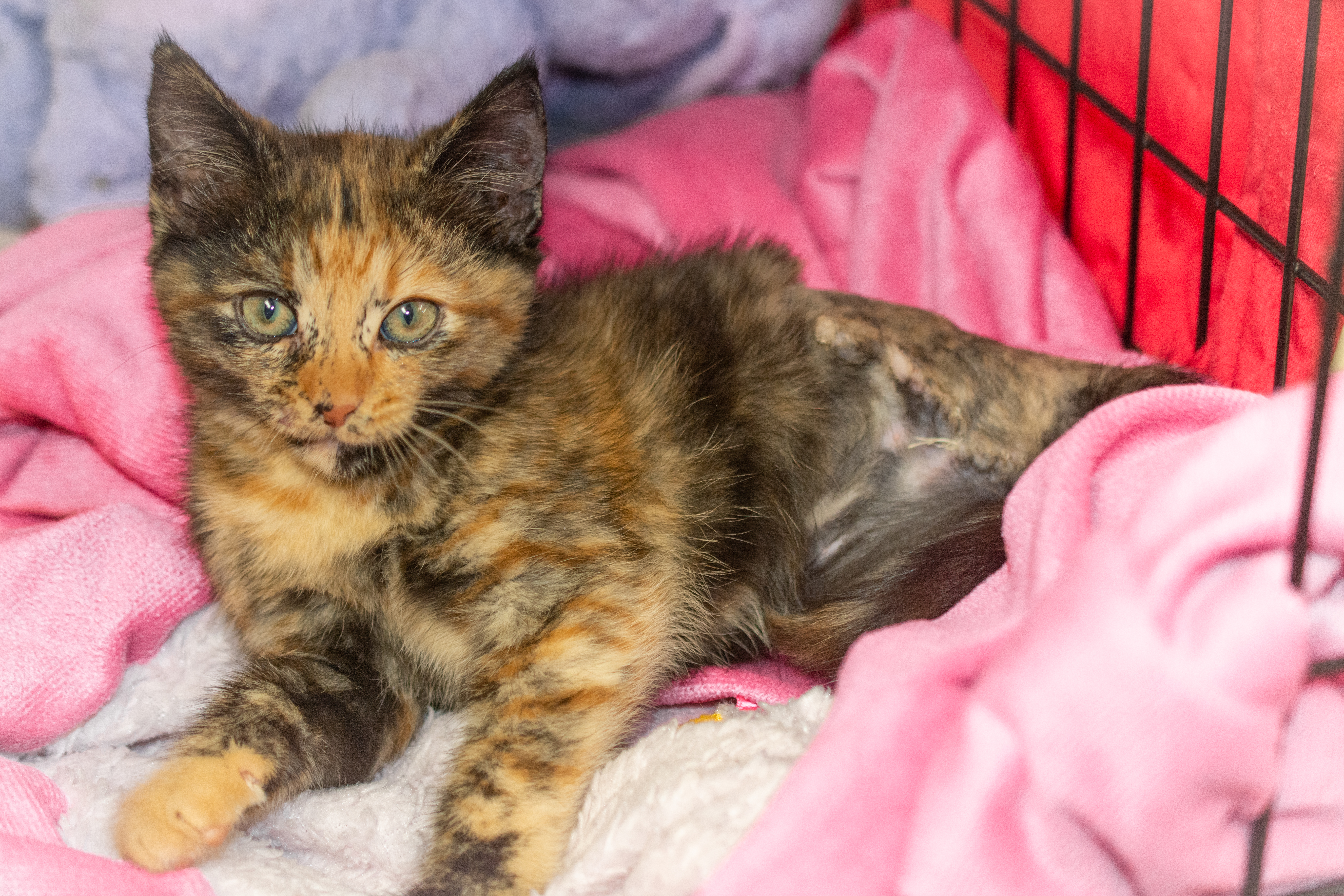
Chelsee was found one dark night on a highway with an open fracture to her back leg. The good Samaritan who found Chelsee rushed her to our shelter. From there, our vice president Mary Ann worked tirelessly making phone calls to find little Chelsee the help she desperately needed. She managed to find a vet willing to wait and evaluate this poor kitty, so Mary Ann and our dog manager Jen rushed Chelsee to Forest Hills vet where Dr. Chelsee admitted and treated her. That's where our sweet kitten got her name. Sadly, Chelsee had to have her leg amputated, but she is making a marvelous recovery at FFF! She is sweet, friendly, and gentle, and she purrs like a racecar when she is being petted. This resilient kitty should be ready for adoption soon. We hope you don't let the missing leg deter you! Most tripod cats are very active and extremely proficient with three legs, and Chelsee is no exception.
Emergencies like Chelsee come in frequently, so if you are able to donate to our emergency fund, your money will go towards helping animals like Chelsee.
10/1/2020
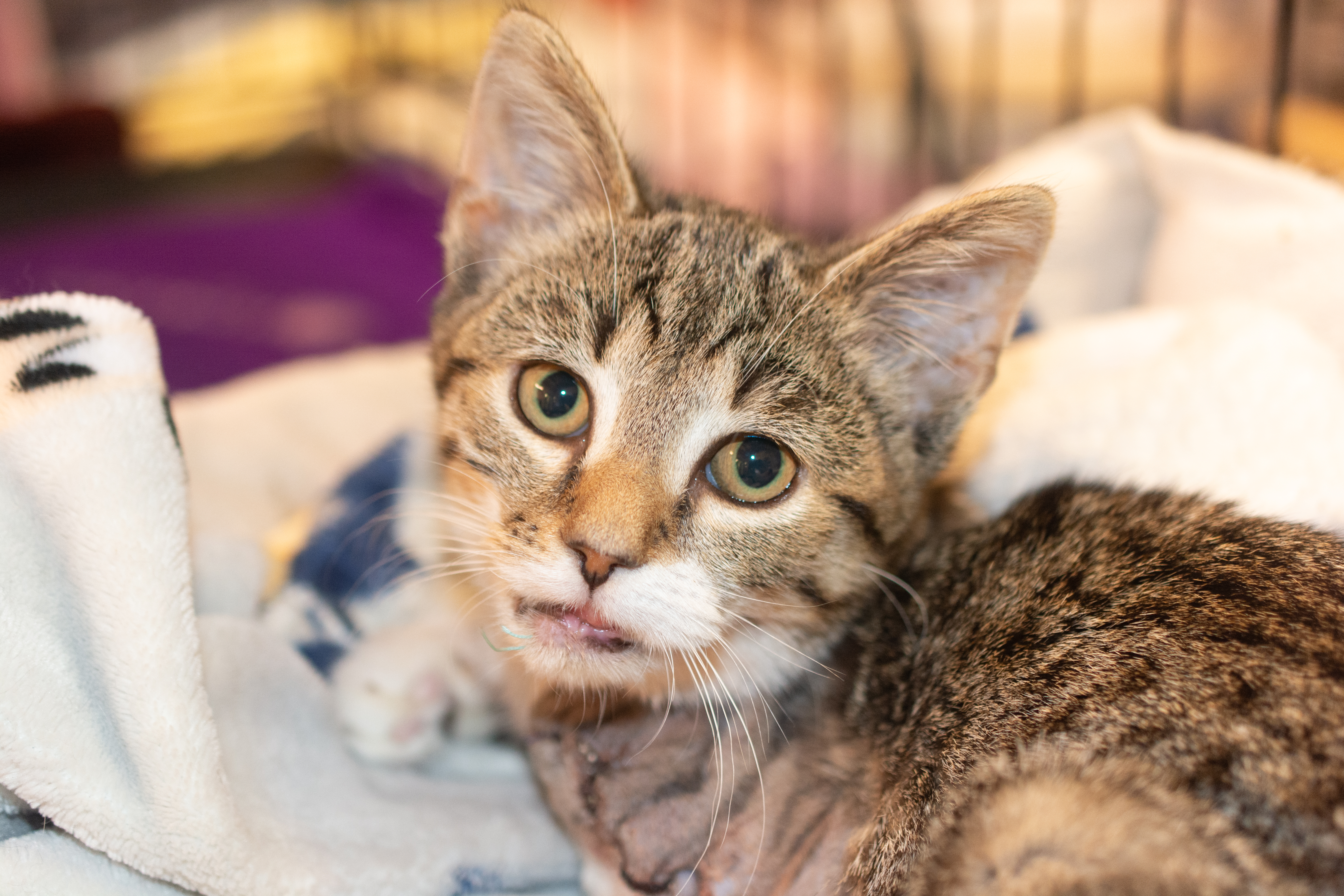
Little Bit is a sweet female kitten who was found in someone’s back yard. She was hiding in the shrubs, and the rescuer noticed that she was injured. We think Little Bit was approximately 8 weeks old when she was found.
Little Bit’s vet visit confirmed that she had some serious injuries. Our vet stated that her injuries were consistent with a kitten that climbs up under the hood of a car. When the engine starts, the moving parts cause injury to the animal.
Little Bit had a degloving injury to her lower jaw and a badly mangled front leg. Dr. Becky was able to repair the soft tissue injury to Little Bit’s jaw. Luckily, she did not have a jaw fracture. However, her front leg had been rendered useless from nerve damage caused by the injury, so our Little Bit had to have that front leg amputated.
Little Bit has been a trooper throughout her rescue and medical care. She is now recovering and learning how to navigate well on her three legs. She is a cuddly, loving little girl who doesn’t let being three-legged slow her down. We often see her climbing the sides of her crate and she is quite mobile when she is out of the crate. She will make a great Little Bit of a kitty for her forever family.